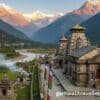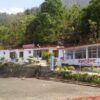Valley of Flowers National Park
Valley of Flowers National Park is an Indian national park in the state of Uttarakhand located in the Chamoli district, known for its beauty. Valley of the Flowers is a bouquet in the west Himalayan region of Uttarakhand state. The trek to the Valley of Flowers goes through dense forests, along with the Pushpawati River and can be reached by crossing many bridges, waterfalls, and glaciers on the way. The glaring price of nature is an Indian National Park and UNESCO World Heritage Site.
About Valley of Flowers
The area of the Valley of Flowers is rich in flora and fauna. The Valley of Flowers was declared a National Park in the year 1982 and is now a UNESCO World Heritage Site. The virgin beauty of this beautiful valley has always attracted botanists, nature lovers, travelers, adventure sports and photographers also.
Situated at 3,658 meters in the Bhyundar Valley, the valley of flowers in the Chamoli district sprawls over a vast expanse of 87.50 sq. Kms, measuring 8 km long and 2 km wide, is the second zone of the Nanda Devi Biosphere Reserve with numerous waterfalls, white shiny glaciers and thickets that greet the visitor at every step. Ghangaria is a small hamlet situated at 13 km from Govindghatis the last human habitation center on the way to the Valley of Flowers.
Top 10 Summer Treks in Uttarakhand
The valley of flowers seems to change its color throughout the season from May to October, as it blooms hundreds of different flowers, taking various colors and shades as time progresses. The valley is the home of some rare flowers like the Brahma kamal, the blue poppy and the cobra lily. This place is a much-sought destination for flower lovers, nature lovers, photographers (nature photographers/wildlife photographers), and bird watchers. The valley is very popular among International tourists, and thousands of foreigners come to the Valley of Flowers every year.
Valley of Flowers National Park Travel Tips
Start early from Ghangharia to spend more time in the Valley of Flowers. It is a world heritage site and therefore you need to enter your name in the register, pay the entry fee and declare all plastic bottles you are carrying.
Entry to Valley of Flowers opens at 7:00 AM every morning and the last entry is allowed till 2:00 PM. You should start back around 1 PM so that you can reach back by 5:00 PM.
Carry an extra pair of socks, torches, Raincoats, and Extra Batteries for your Camera. Because you will see every possible opportunity for photography.
The Valley is beautiful in the months of May, June and September. But for the maximum number of flowers, the preferred months are July and August.
History of Valley of Flowers
In the year 1931, three British mountaineers, Frank S. Smythe, R.L. Holdsworth and Eric Shipton lost their path while returning from Mt. Kamet. The group accidentally reached a valley that was blanketed with alpine flowers and was left in awe of its beauty, thus naming it “The Valley of Flowers”. One of the climbers, Frank S. Smythe, later wrote the book ‘Valley of Flowers. In 1939, Joan Margaret Legge (21 February 1885 – 4 July 1939), a botanist deputed by the Royal Botanic Garden,s arrived at the valley to study the flowers and while traversing some rocky slopes to collect flowers, she slipped off and lost her life. Her sister later visited the valley after her death and erected a memorial near the spot. Professor Chandra Prakash Kala, a botanist at the Wildlife Institute of India, carried out the research study on the floristics and conservation of the valley of flowers for a decade, beginning in 1993. He invented 520 alpine plants exclusively growing in this National Park and authored two important books – “The Valley of Flowers – Myth and Reality” and “Ecology and Conservation of the Valley of Flowers National Park, Garhwal Himalaya.
Management System
The National Park is administered by the Uttarakhand State Forestry Department, the National Ministry of Environment and Forests, India. There is no settlement in the park and grazing has been banned since 1983. The park is open only during summer from June to October and it is covered by heavy snow for the rest of the year.
Mythology about the Valley of Flowers
The locals always know about the existence of the valley and it is believed that this area was inhabited by Fairies and Gods.
Entry fee to the Valley of Flowers
- For Indians: 150 INR
- For Foreigners: 600 INR
Trek Update: A swift trek route to the Valley of Flowers has been carved which will easily guide you toward the beautiful floral valley. To make your sojourn rewarding, a new motorable bridge has been built in Govindghat connecting 4 Km towards the Valley of Flowers till Pulna village. So now tourists have to visit only 10 Km to reach Ghangaria(base camp of the Valley of Flower trek).
Travel Guide Valley of Flowers
Planning to visit the Valley of Flowers, but you are not sure about the most popular way, so here we are to help you. Check the details here.
Day 1: Rishikesh – Joshimath (255 Km) 9 Hours
- Road Distance: 255 Km
- Time Taken: 9 Hours
- Altitude Change: 372 meters at Rishikesh to 1875 meters at Rishikesh.
Early morning leave Rishikesh for Joshimath it will take up to 9 to 10 hours to reach. Joshimath is 255 km away from Rishikesh, and it is the winter abode of Lord Badrinath. You’ll reach Joshimath by evening, and check in at any hotel that suits you for a night’s stay. You can get direct buses from Rishikesh bus station to Joshimath if you are looking for a comfortable journey you can also book a taxi to Joshimath from Rishikesh.
Garhwali Traveller tip 1: To save money, use public transport to Joshimath. In case of no direct bus to Joshimath, break your journey into parts to reach your destination or go for sharable vehicles like Maxx service or Tata Sumos which are easily available.
Road route: Rishikesh – Devprayag – Srinagar – Rudraprayag – Karanprayag – Nandprayag – Chamoli – Joshimath
Day 2: Joshimath – Govindghat – Ghangaria
- Road distance: 20 Km
- Trekking distance: 1 hour by road and 6 hours for a trek(trekking distance may vary depending upon your speed and stamina)
- Trek grade: Moderate
- Altitude change: 1828 meters at Govindghat and 3049 meters at Ghangaria
After breakfast, drive to Govindghat which is about 22 km away from Joshimath. Start your trek journey towards Ghangaria with a packed lunch. Ghangaria is also known as Govind Dham, it is the base camp for Hemkund Sahib and the Valley of Flowers trek. After completing the 10 km trek journey, you will reach Ghangaria where you will spend the night.
Note: The distance of 4 Km from Govindghat to Pulna village is motorable. Earlier you had to walk 14 km to reach Valley of Flowers National Park. But after the 2013 flood in Uttarakhand, a new route has been constructed by the Uttarakhand government for travelers visiting Hemkund Sahib and the Valley of Flowers.
Garhwali Traveller travel tip 2: If trekking is tough for you then there is also a good option for you at Govindghat, there are plenty of ponies. You can book them for your journey to Ghangaria. However, to enjoy the views and trek route, we will recommend trying to trek yourself to be strong.
Day 3: Ghangaria – Valley of Flowers – Ghangaria
- Trekking distance: 7.5 Kms for both sides
- Time took: 2 hours for one side(depending on your strength and speed)
- Trek grade: Easy
- Altitude change: 3049 meters at Ghangaria and 3658 meters at Valley of Flowers
Your hard work and the journey will finally pay off in the form of a beautiful Valley of Flowers. Here you will see flowers you have never seen before, exotic Himalayan flowers and wildlife flora and many more.
Day 4: Ghangaria – Govindghat – Joshimath
Now it’s time to return home, post breakfast, start your 10 Kms trek to Govindghat and then drive to Joshimath via Badrinath. On reaching Joshimath, check in for the hotels to stay for the night.
Day 5: Joshimath – Rishikesh
After having breakfast, drive to Rishikesh and say goodbye to the beautiful hills.
Note: You can extend your stay at Ghangaria for one more day and visit Hemkund Sahib as well, which is 6 Kms from Ghangaria.
Valley of Flowers National Park Highlights
- Easy trek for beginners
- One of the most beautiful valleys in the world
- More than 500+ flower species and plants are found here
- The valley changes its color throughout the season
- A huge variety of birds and butterflies
- Snow-covered mountains and glaciers visible from the valley
- Beautiful waterfalls, streams, lush green meadows and forests during the trek to the valley
Valley of Flowers National Park Overview
- The Temperature in June: 6 to 16 degrees Celcius
- Trek to Valley of Flowers starts from: Govindghat or Pulna village
- Trek distance: 17 Km
- Trek grade: Easy for professionals and difficult trek for beginners
- Trek duration: 3 days
- Location: Chamoli District
- Recommended stay: 4 days minimum
- Altitude range: 3500 meters
- Nearest railway station: Rishikesh, 273 Kms
- Nearest airport: Jolly Grant Airport, Dehradun, 292 Kms
- Famous for: Trekking, Flowers, Flora and Fauna, UNESCO Site, Vegetation
- Best times to visit Valley of Flowers: May, June, July, August, September, October and November
What is the best time to visit the Valley of Flowers?
The Valley of Flowers is open for visitors from June to October. However, the best time to visit is between July and August when the flowers are in full bloom.
How do I reach the Valley of Flowers?
The Valley of Flowers is located in Uttarakhand, India. The nearest airport is in Dehradun, and the nearest railway station is in Rishikesh. From there, you can hire a taxi or take a bus to Govindghat and then trek to the Valley of Flowers.
Is there an entry fee for the Valley of Flowers?
Yes, there is an entry fee for the Valley of Flowers. Indian visitors need to pay INR 150 per person, and foreign visitors need to pay INR 600 per person. The fee is valid for three days.
What is the difficulty level of the trek to the Valley of Flowers?
The trek to the Valley of Flowers is considered moderate in difficulty. The trail is around 14 km long and has a gradual ascent. However, it can be tiring for those who are not used to trekking.



